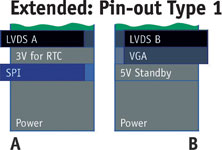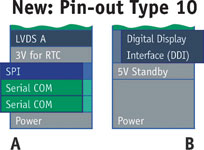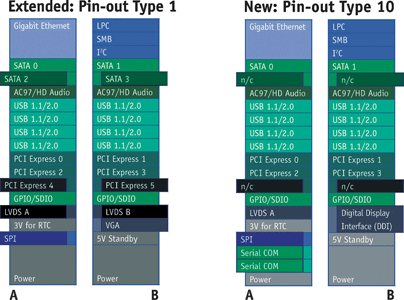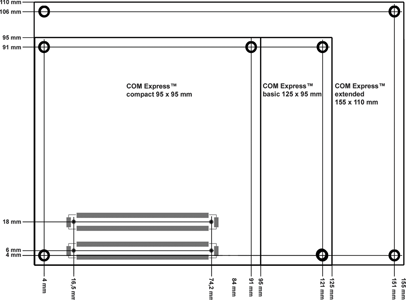
The first part of this article ran in the 29 September issue of Dataweek.
In pin-out type 1, SATA ports 2 and 3 are assigned pins in rows A and B, but these are no longer reserved in pin-out type 10. The pins could still be used as SATA ports, but are now reserved for alternative purposes such as USB 3.0. So in designs for pin-out type 1 as for type 10, Kontron advises against wiring SATA 2 and 3 over the module connector. The modules then remain compatible, and they are ready for USB 3.0 at the same time. Figure 1 illustrates the differences.


Figure 1 shows another difference in rows A and B, this time regarding the pinning of the PCIe lanes, where pin-out type 1 offers six lanes in total. In pin-out type 10, the pins for PCIe lanes 4 and 5 are no longer reserved and can also be used for upcoming technologies. The background in both the above cases is as follows: processors of a small form factor, at which type 10 aims, support up to two SATA interfaces and four PCIe lanes. The vacated pins on the module connectors of the ultra standard can therefore be used efficiently for new purposes.
As of COM.0 Rev. 2.0, serial ports are again supported – by types 6 and 10. The pins for this were previously used for VCC 12 V. However, manufacturers like Kontron ensure compatibility with existing carrier boards by a protective circuit on the module. Developers do not have to completely modify their existing carrier board layout, but can cost- and time-efficiently use the new possibilities.
A further difference is that type 10 uses the second LVDS channel, TV out and VGA to support the SDVO port (or alternatively DisplayPort or HDMI/DVI) via DDI. That is no real loss seeing as VGA will only play a minor role in future. But now type 10 ultra-compact modules (such as the nanoETXexpress-TT) provide native support not only for the latest display interfaces but also for dual independent displays, since they will continue to support an LVDS channel. Figure 3 shows the precise differences in pinning between types 1 and 10.
For customers that already use the nanoETXexpress modules from Kontron, these differences are not likely to be of much consequence: With foresight, Kontron has already reserved the appropriate pins for SDVO support, for instance, on the former VGA and second channel LVDS pins in its nanoETXexpress-SP modules.
Other changes
Further changes affecting all the types of modules available are as follows: The COM Express connector in the present form is now also approved for PCI Express Gen2 signals. Technically speaking, that means no alteration to the connector or its pinning, but the developer must still adhere to new rules for PCIe Gen2 when routing the module and carrier board. Additionally, the AC97 pins are now used to support AC97 and HD audio. Kontron users will already be familiar with this as the majority of Kontron COMs support these audio features.
The following changes have additionally been made in the new version: COM modules type 10 and type 6 now also support SDIO, multiplexed on the existing GPIO signals. Optionally, two 3,3 V TTL serial ports are added (as required by many legacy applications) and here the standard again shows its flexibility in responding to the needs of the market. Both ports can be used for different purposes such as RS232, RS485, CAN bus or other two-wire interfaces.

External BIOS Boot
One change shown in the new specifications affects all pin-outs: in addition to the previous firmware hub, there is a new BIOS and corresponding firmware interface for an internal and external boot implemented in the new generation of processors. This is a serial peripheral interface (SPI), the future interface for firmware flash on the module and carrier board. Ready reserved pins are used for this purpose.
Generally, PICMG allows a choice between two SPI chips, the new COM.0 Rev. 2.0 specifying external firmware support for all module types. The LPC interface was used for this purpose in the earlier version. The new modules must support SPI, but may still additionally flash firmware externally through LPC, ie, if the chipset continues to support it. The reason for this change in firmware flash is that the new small form factor processors only support SPI boot devices.
Compact form factor now officially standard
Inclusion of the smaller compact form factor in the standard is a major innovation. It means that the most widely adopted pin-out type 2 can now also be used in applications with space constraints. COM.0 Rev. 2.0 defines its dimensions as 95 x 95 mm. Aside from the reduced footprint, the physical requirements, connector placement and pin-out are exactly the same as those of the successful basic form factor.
Summary
The updated specification for COM Express modules is an appropriate response to trends in the sector, because the standard can only be sustainable if it adapts flexibly to new demands such as miniaturisation and graphics performance – as Kontron has already shown with its ETXexpress, microETXexpress and nanoETXexpress. The PICMG COM Express COM.0 Rev. 2.0 standard is for embedded developers a good indicator of what the future holds. It will create further confidence if the current PICMG® design guide is speedily matched to the new challenges.

COM Express is, other than the standard adopted in 1998 for DIMM-PC and the one published in 2000 for ETX, the only vendor-independent standard for computer-on-modules. Thus it is extremely important in the embedded market. With Rev 2.0 it is extended by a new form factor and new pin-outs to meet future needs. Thus the strengths of the COM Express concept have been preserved in their entirety: with full compatibility for existing applications, the proven standards have been adapted to the new requirements and new features of the pin-out types 6 and 10 have been implemented. Rev. 2.0 thus provides a sound basis for the next few years.
| Tel: | 087 093 2700 |
| Email: | [email protected] |
| www: | www.osiris.co.za |
| Articles: | More information and articles about Osiris Technical Systems |

© Technews Publishing (Pty) Ltd | All Rights Reserved